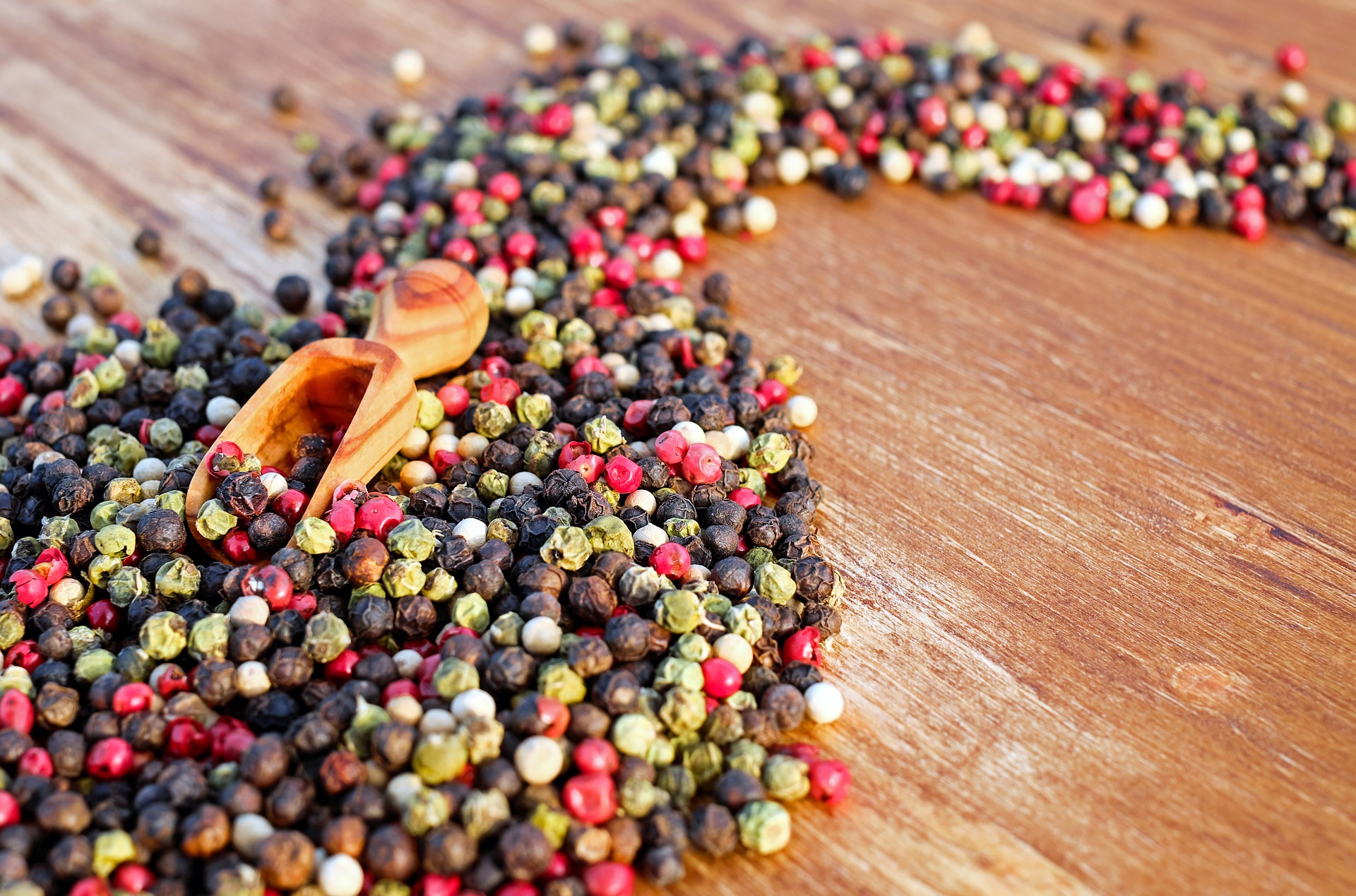
Black pepper (Piper nigrum)
Plant:
The pepper tree is an Asian vine, from the Piperaceae family, which produces the queen of spices: black, green, red, or white pepper. These berries have a flavor and intensity of properties that only vary with maturity, sun-drying time, and further processing.
Black pepper has always been the most popular in the world. Remember that black pepper ended up being traded in the Middle Ages as a currency – at the time it was worth as much as gold – but today it is sold at an affordable price for everyone. The secret of the success of this spice is due to its strong, slightly spicy flavor with hints of orange and wood, and the high level of piperine – compared to green, red or white berries, black is the one that offers the greatest intensity of this chemical compound – and especially its properties and benefits for the Human Being. It’s no coincidence that it’s the most wanted in the world for cooking, prevention, and healthcare – treats pneumonia in 20 minutes (read how to do it below) – or for making cosmetic products, among others.
The world is familiar with pink pepper, considered to be “false” pepper, which is the fruit of another pepper plant, Schinus molle, from the cashew family. Pink pepper is aromatic, does not have a spicy flavor and is widely used for decoration in cooking and also has human health benefits (read more in an article on this site).
Properties:
Antioxidant, anti-inflammatory, thermogenic, analgesic, antiseptic, digestive… These are some of the properties of black pepper which is rich in iron, calcium, zinc, potassium, magnesium, chromium, manganese, and vitamins A and C, between others.
Benefits:
- accelerates metabolism,
- relieves muscle pain,
- natural antidepressant,
- joints,
- arthritis,
- osteoarthritis,
- cholesterol,
- colic,
- fights free radicals, protects against degenerative diseases,
- cold,
- helps reduce blood sugar,
- diarrhea,
- digestion,
- intestinal gas,
- gout,
- improves nutrient absorption,
- improves mood,
- memory,
- pneumonia,
- reduces weight,
- circulatory system,
- nervous system…
How to consume:
Black pepper can be consumed as a grain, powder, or oil (in the latter case it is intended for external application). A pinch or two of this spice per day in your diet is enough to obtain the great benefits that this plant is ready to offer us. To get the most out of it, powder the pepper or grind its fresh peppercorns only at the end of cooking or on the plate, as high temperatures reduce its benefits. Peppercorns can also be used to decorate sweet or savory dishes.
For health care, black pepper, for example, assumes a fundamental role in the cure of pneumonia which can cause fevers up to 41ºC. Fever is our body which fights lung infections and the action of black pepper intensifies this fight. A compress of black pepper on the affected area will raise the temperature even more and attract the bacteria or virus that causes the infection to the surface of the skin. This is why after 20 minutes of applying a compress of black pepper, the skin turns red, that is, the virus or bacteria dies and the infection is treated.
How to make a compress with ground pepper to place on the affected lung area: on the back or on the chest?
Necessary material:
- 100 grams of ground black pepper,
- two medium-sized white leaves,
- a teaspoon,
- a glass,
- half a liter of boiling water,
- a thermal bag heated between 45 ° C and 50 ° C,
- a transparent plastic bag.
Start by placing the 100 grams of ground pepper in a glass – it should only take part of its size – then pour the equivalent into boiling water (be careful not to burn yourself) and stir very well with a teaspoon, until you gain a pasty form. Open a towel and spread the black pepper paste in half to cover the entire area of the affected lung. This should be done quickly so that the dough does not cool down. Then close the towel with the other half to make the compress, place the thermal bag heated to 50 ºC on top and wrap with a plastic bag so that the temperature remains high. Finally, use the second towel to cover the plastic bag and your compress is ready to be applied to the affected lung for 20 minutes.
After, you need to lift the compress and see how the person’s skin is:
- The red skin indicates that the treatment has worked, that the pneumonia is cured, and within three to four hours the fever will start to subside.
- The skin did not turn red, so the treatment did not have the desired effect. Reheat the bag of hot water and, within 40 minutes, repeat for another 20 minutes. After this time, lift the compress and you will see that the skin is red, that is, the pneumonia is over.
Contraindication:
Children and people with gastric imbalances, such as gastritis, ulcers, hiatus hernia, gastric hypersensitivity, or hemorrhoids and fissures. Therefore, it is advisable to be careful, since each body is different and to allow possible incompatibilities, total or momentary, generated by its ingestion or its application.
This text is an awareness. Depending on the season and the moment in which you are, it is up to each Being to feel whether he should consume this food. The dosage and frequency depend on the nature and physical condition of each Human Being.




